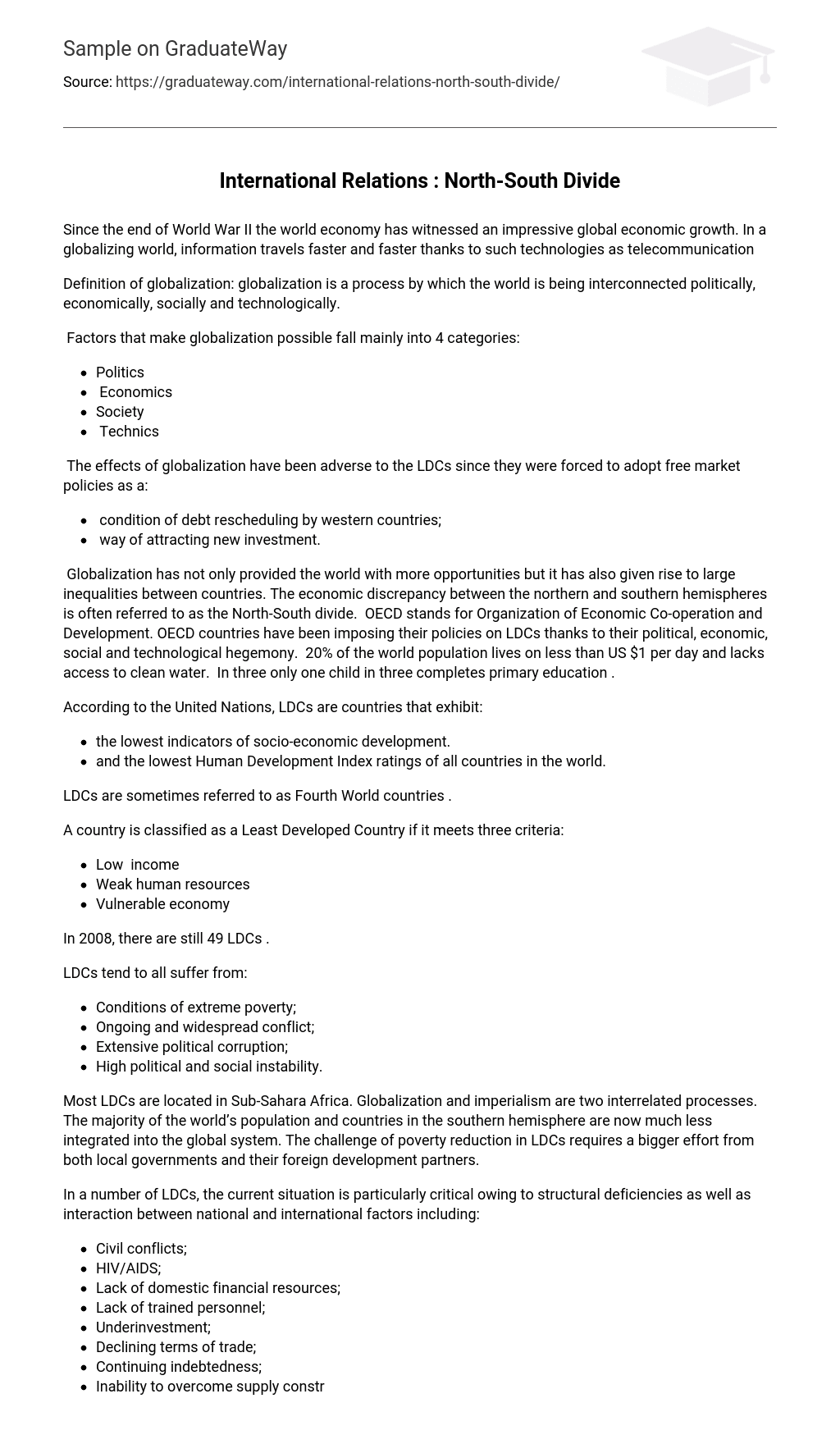Since the end of World War II the world economy has witnessed an impressive global economic growth. In a globalizing world, information travels faster and faster thanks to such technologies as telecommunication
Definition of globalization: globalization is a process by which the world is being interconnected politically, economically, socially and technologically.
Factors that make globalization possible fall mainly into 4 categories:
- Politics
- Economics
- Society
- Technics
The effects of globalization have been adverse to the LDCs since they were forced to adopt free market policies as a:
- condition of debt rescheduling by western countries;
- way of attracting new investment.
Globalization has not only provided the world with more opportunities but it has also given rise to large inequalities between countries. The economic discrepancy between the northern and southern hemispheres is often referred to as the North-South divide. OECD stands for Organization of Economic Co-operation and Development. OECD countries have been imposing their policies on LDCs thanks to their political, economic, social and technological hegemony. 20% of the world population lives on less than US $1 per day and lacks access to clean water. In three only one child in three completes primary education .
According to the United Nations, LDCs are countries that exhibit:
- the lowest indicators of socio-economic development.
- and the lowest Human Development Index ratings of all countries in the world.
LDCs are sometimes referred to as Fourth World countries .
A country is classified as a Least Developed Country if it meets three criteria:
- Low income
- Weak human resources
- Vulnerable economy
In 2008, there are still 49 LDCs .
LDCs tend to all suffer from:
- Conditions of extreme poverty;
- Ongoing and widespread conflict;
- Extensive political corruption;
- High political and social instability.
Most LDCs are located in Sub-Sahara Africa. Globalization and imperialism are two interrelated processes. The majority of the world’s population and countries in the southern hemisphere are now much less integrated into the global system. The challenge of poverty reduction in LDCs requires a bigger effort from both local governments and their foreign development partners.
In a number of LDCs, the current situation is particularly critical owing to structural deficiencies as well as interaction between national and international factors including:
- Civil conflicts;
- HIV/AIDS;
- Lack of domestic financial resources;
- Lack of trained personnel;
- Underinvestment;
- Declining terms of trade;
- Continuing indebtedness;
- Inability to overcome supply constraints.
Give 5 Strengths, Weaknesses, Opportunities and Threats of LDCs (5 points):
Strengths:
- Young population
- Abundant human resources
- Stronger growth rate than developed countries’
- Abundant mineral resources
- Increasing important markets to developed countries
Weaknesses:
- Lack of qualified people
- Lack of capital
- Heavily indebted
- Uncompetitive products
- Few women involved economy development
Opportunities:
- Technological progress (e.g.I.T.)
- Development of world tourism industry
- International community awareness increase
- Increasing presence of NGOs as both aid agencies and watchdogs
- Involvement of multilateral and bilateral financial institutions
Threats:
- Diseases (HIV, Malaria, etc.)
- Social and economic instability
- Maladministration
- Corruption
- Misdistribution of wealth
LDCs’ poverty problems need to be tackled both at national and international levels to be eventually solved in the long term. The best trace-poverty relation is found in countries that opened up moderately in the 1990’s. In an effective LDC development strategy women should not be left out of employment opportunities. National development strategies need to be tailored to specific countries. ODA stands for Official Development Assistance. FDI stands for Foreign Direct Investment. Despite various initiatives to eliminate the debt burden of LDCs, external debt remains a major problem for most of them.
HIPC stands for Highly Indebted Poor Countries. According to experts, LDCs need to be at the heart of the new trade geography. GSTP stands for Global System of Trade Preferences . LDCs offer the international community not only potential markets but also many supply opportunities. The WTO was established in 1995 (year) . WTO is a body designed to supervise and liberalize international trade. WTO is the successor to the General Agreement on Tariffs and Trade (GATT).
What is the role of WTO? : it is responsible for negotiating and implementing new trade agreements. It is also in charge of policing member countries’ adherence to all the WTO agreements, signed by the majority of the world’s trading nations and ratified in their respective parliaments.
The WTO has 153 members, which represents more than 95% of the world trade. Four out of five WTO members are developing countries. The multilateral trading system promoted by the WTO is critical LDCS’ future since it has done more to boost living standards and lift people out of poverty than any other government intervention. Developing countries with open economies have grown much faster over the last decades than those with closed economies. Free trade boosts economic growth and so helps to alleviate poverty. Trade liberalization is essential for growth and development. When people get richer by exchanging goods with each other, they are less likely to fight each other. When governments adhere to WTO rules that prescribe transparency and predictability, there is scope for corruption. WTO aims to help LDCs integrate into the world economy. The WTO works as a unifying body between the different international aid agencies. LDCs need to draft domestic laws that comply with WTO rules.





